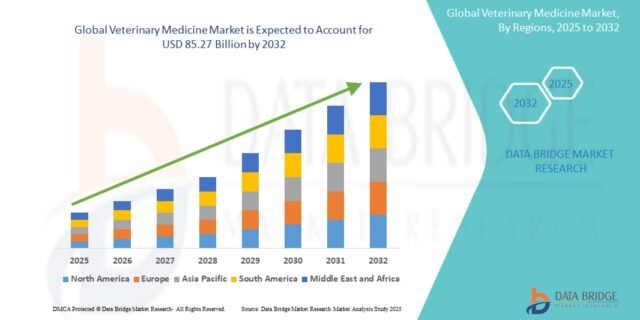Introduction
The veterinary medicine market plays a vital role in ensuring animal health, food safety, and public health. With the rising demand for both companion and livestock animal care, this market has expanded significantly in recent years. The growth is driven by increased pet ownership, livestock production, zoonotic disease prevention, and advancements in veterinary diagnostics and therapeutics.
Veterinary medicine includes a wide range of products such as vaccines, parasiticides, anti-infectives, and nutritional supplements, as well as veterinary services provided by clinics and hospitals. The industry is strongly influenced by evolving regulations, animal welfare concerns, and technological innovations.
Source – https://www.databridgemarketresearch.com/reports/global-veterinary-medicine-market
Market Overview
Veterinary medicine encompasses pharmaceuticals and biologics developed specifically for animals. The market serves two primary animal categories:
- Companion Animals: Dogs, cats, horses, and other pets
- Livestock Animals: Cattle, poultry, swine, sheep, goats, and aquaculture
The products are designed to diagnose, treat, and prevent diseases and improve animal performance and welfare. Veterinary medicine also contributes to food security by ensuring the health and productivity of food-producing animals.
Key Market Drivers
1. Rise in Pet Ownership
The human-animal bond is stronger than ever, particularly in urban areas. With pets seen as family members, pet owners are more willing to spend on healthcare, insurance, nutrition, and wellness, contributing to demand for veterinary products and services.
2. Growth in Livestock Production
Increasing global demand for meat, dairy, and other animal-based products has led to intensive livestock farming. This creates a growing need for vaccines, antibiotics, and nutritional supplements to maintain animal health and prevent disease outbreaks.
3. Technological Advancements
Digital tools such as telemedicine, wearable health monitors, and AI-driven diagnostics are improving veterinary services. Innovations in biotechnology have also enhanced vaccine development, drug formulations, and disease detection.
4. Zoonotic Disease Awareness
Outbreaks like avian influenza, swine flu, and COVID-19 have raised awareness about the link between animal and human health. Veterinary medicine is central to One Health initiatives aimed at preventing zoonotic diseases.
5. Government and NGO Initiatives
Supportive regulations, subsidies for livestock vaccination programs, and animal welfare laws have positively impacted the market. Programs led by organizations like the World Organization for Animal Health (OIE) promote veterinary capacity worldwide.
Market Challenges
1. Antimicrobial Resistance (AMR)
The misuse of antibiotics in animals has contributed to AMR, leading to stricter regulations on veterinary drug use and challenges for pharmaceutical development.
2. High Cost of Advanced Treatments
While pet owners are spending more, high-end veterinary procedures and biologics can be costly, limiting access in lower-income areas or among large-scale livestock farmers.
3. Regulatory Compliance and Approval Delays
Veterinary drugs and vaccines must comply with stringent safety standards, which can lead to long approval timelines, increased costs, and delayed product launches.
4. Limited Veterinary Infrastructure in Developing Regions
Access to trained veterinarians, diagnostic labs, and reliable distribution networks is often inadequate in rural and low-income regions, affecting market penetration.
Market Segmentation
By Product Type
- Pharmaceuticals (Anti-infectives, Anti-inflammatory, Parasiticides, Others)
- Vaccines (Live Attenuated, Inactivated, Recombinant, Toxoid)
- Medicated Feed Additives
- Diagnostics and Testing Kits
- Veterinary Instruments and Equipment
By Animal Type
- Companion Animals (Dogs, Cats, Horses, Others)
- Livestock Animals (Cattle, Poultry, Swine, Sheep & Goats, Others)
By Route of Administration
- Oral
- Injectable
- Topical
- Others (Implants, Inhalation)
By Distribution Channel
- Veterinary Hospitals and Clinics
- Retail Pharmacies
- Online Pharmacies
- Wholesalers and Distributors
Regional Insights
North America
A mature market led by the U.S. due to high pet adoption rates, strong veterinary infrastructure, and R&D investment. Companion animal care is a key growth area.
Europe
High awareness of animal welfare and strong public policies support this market. The UK, Germany, and France are among the largest contributors.
Asia-Pacific
Rapid growth due to expanding livestock industries in China, India, and Southeast Asia. Rising income and pet adoption in urban areas are further boosting demand.
Latin America
A significant livestock sector and increasing awareness about veterinary care are supporting market growth in Brazil, Mexico, and Argentina.
Middle East & Africa
Still developing, with focus on livestock vaccines and disease control in pastoral communities. Growth potential remains high with increasing public-private partnerships.
Competitive Landscape
The veterinary medicine market is dominated by a mix of global pharmaceutical giants and specialized veterinary drug manufacturers. Key players include:
- Zoetis Inc.
- Elanco Animal Health
- Merck Animal Health
- Boehringer Ingelheim Animal Health
- Ceva Santé Animale
- Virbac
- Vetoquinol S.A.
- IDEXX Laboratories
- Dechra Pharmaceuticals
These companies are investing in R&D, expanding product portfolios, and focusing on emerging markets to maintain competitive advantage.
Future Outlook
The veterinary medicine market is poised for strong growth in the coming years, driven by factors such as:
- Continued pet humanization and premiumization
- Increased livestock productivity demands
- Rising disease surveillance and One Health integration
- Expansion of veterinary telehealth and remote diagnostics
- Growth in biologics, including monoclonal antibodies and DNA-based vaccines
Although regulatory and cost challenges persist, innovations and awareness are expected to keep the market on a positive trajectory.







